Journey of Learning Liszt's Hungarian Rhapsody No. 2
I was very young when I first heard it. Many remember, I'm sure, the classic episode of Tom and Jerry, where a well-dressed Tom enters a concert stage and begins playing the famous tune, only to be thwarted by Jerry, who has been taking a nap inside of the piano. The battle that ensues is so well choreographed with Liszt's masterpiece, one would think he wrote the piece specifically for that Tom & Jerry episode.
Of course, Franz Liszt passed from this world years before the invention of moving pictures, leaving in his wake some of the most beautiful works in all of classical music. Among them, are the 19 Hungarian Rhapsodies - expressive, virtuosic pieces based on the melodies and themes of Hungarian Gypsy music of Liszt's time. The second Hungarian Rhapsody is the most famous one - and is featured in the aforementioned Tom and Jerry episode The Cat Concerto. The theme that develops in the latter section of the piece is perhaps one of the most recognizable ones in all piano music (whether or not that is still the case for the current generation is a question I'd rather not know the answer to).
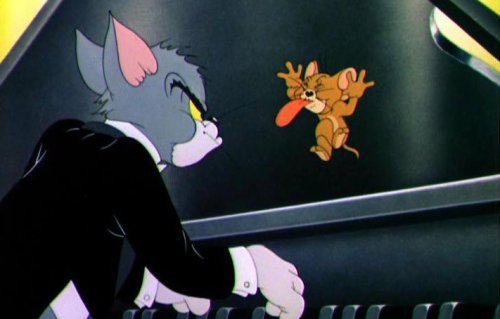
A scene from the infamous Cat Concerto episode
As a child, I heard this tune in many other settings aside from Tom and Jerry, but in my head it has always remained as the song that the cat and mouse unknowingly create by bickering on top of a keyboard of a concert grand. And I fantasized about being able to play it! Among other fantasies and dreams, of course - children are like whirlwinds. When I was little, I had many interests, including painting, martial arts, math, learning to speak English as my third language... I did take piano, oboe, and music theory classes, but among all my other childhood activities, I didn't realize that music would be the one that I would really develop into adulthood. The possibility of playing the Second Hungarian was just a pet fantasy, long forgotten by the time I became interested in computer programming as a teenager in high school. However, it was also during this time that I became borderline obsessed with guitar - which carried my musical torch until, under the tutelage of a talented piano playing friend, I began practicing piano again. I quickly got my technique back and after getting through some difficult pieces, including some by Liszt himself, I decided I wanted to take my childhood fantasy a little more seriously. In this article, I'm going to detail my journey from when I first opened up this twenty-page behemoth until just a few months ago, when I finally got through the last page and performed it for the first time.
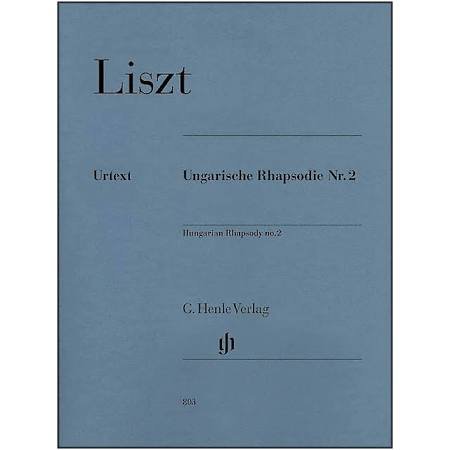
The Score
This rhapsody is divided into two parts: The Lassan and the Friska. Lassan is slower and somber, whereas the Friska is faster and festive. Furthermore, the Lassan, while being written in C# minor, actually opens up with a few bars in C# major, before establishing the minor feel that continues throughout. The Friska, conversely, is written in F# Major (sub-dominant of C#), but the beginning few bars are in F# minor. The progression in these few minor bars gradually builds up tension, at the height of which the Friska switches to F# major and becomes very festive, increasingly building up the levels of energy, until it temporary slows down and switches back to F# minor. This section is followed by Listz's invitation for the performer to write or improvise a cadenza, just before the grand finale, which brings the piece back to F# major with octave runs that go up and down the entire keyboard and end with three triumphant chords (this is that part when Jerry takes over the piano hammers and gives Tom a run for his money). The crowd goes nuts at this point.
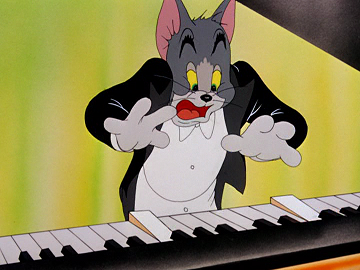
Tom's confusion, as Jerry hammers the finale
I listened to this rhapsody over and over, gobbling up different renditions from various performers. Pretty soon I had the whole thing memorized and could play it in my head, on an imaginary piano. This built up very intense emotions of excitement and became the basis for my motivation. From having learned many difficult pieces on various instruments, I would definitely say that one's own imagination and attitude will have a tremendous effect on the level of success. As Victor Wooten said in his book "The Music Lesson", a child playing air guitar plays no wrong notes. This playful attitude slashes all frustration to ashes, keeps us from taking ourselves too seriously, and allows us to spend large chunks of time persevering through a piece of music without an ounce of boredom.
Despite my playful attitude, the latter part of the Friska intimidated me. I had no idea how in the world I would play all the energetic runs on the right hand, nor could I imagine myself executing the chord jumps that spanned several octaves on the left hand. The score made me dizzy. So I put it out of my mind temporarily and began with the Lassan. I thought the biggest challenge with this section would be the three quasi-cadenzas that occur throughout. These are fast runs of the right hand that go up and down the keyboard and sound quite impressive. They look difficult on the page, but when I actually got to them, I was pleased to find that they were easier to do than they seemed. Each quasi-cadenza consists of only a few notes that simply repeat in different octaves - learn to execute it in one octave and you're golden.
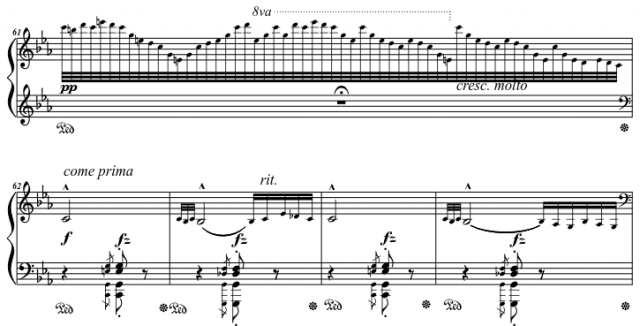
Quasi-Cadenza
What really proved to be a challenge were the more subtle elements of the music - the dynamics and getting those beautiful melodies to really sing. There are a few melodic runs in the Lassan that consist of a series of thirds, played by the right hand, while the left hand plays somber waltz-style chords. This melody requires the pianist to play two notes at the same time with one hand and transition smoothly from third to third at a fairly brisk tempo as the melody progresses. Getting the mechanical part - alternating from one set of fingers to the next was just a matter of repetition and practice. Getting that melody to really ring out and sound lyrical, on the other hand, was something that I could not achieve until I began seeing a classical piano teacher on a regular basis.
At this point I'd like to mention the importance of having a teacher when tackling such difficult pieces of music. Sure, it is quite possible to read through the music and play all the notes, if one has the patience and the grit to do so. It is even possible, through repetition, to play these notes at the intended tempo and even get all of them right. However, there is so much more to the music than merely playing all the notes fast. The dynamics, tone color, quality of sound... Not to mention the fact that getting all the notes 'right' is not sustainable if the pianist's technique puts unnecessary strain on the body. Good teachers will not only recognize where work needs to be done, they will have specific suggestions on technique and practice that will achieve the intended result. You may have a different musical vision than your teacher, but having that guidance will help tremendously nevertheless. If you cannot afford a regular teacher, even one-time consultations every once in a while will go a long way.
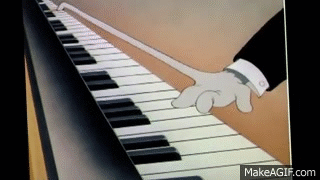
Teacher's guidance can help make these jumps as smooth as Tom's
I learned the Lassan relatively quickly and began performing it, citing the difficulty of the piece and my busy schedule as reasons for not being able to play the second movement. I did eventually begin working on the Friska, getting through the minor key section, but stopped once I got to the chord-heavy energetic section. The Lassan on it's own is still quite beautiful, my audiences were always pleased with it, so I let myself stagnate - the seemingly dazzling difficulty of the Friska kept me putting it off. I learned other pieces, focused on developing my guitar technique, venturing into jazz and also playing in a flamenco band. The second Hungarian became an afterthought again. Then, a few years later, I met my teacher Elaine.
Elaine pointed out that my performance of the Lassan - even after all these years of playing it - was rather dull and lacking in color and vibrancy. She pointed out that my hands and body were stiff and my music didn't flow as freely as it could. She said that technical passages would never be a problem for me - and for that reason I had no excuse not to learn the piece all the way through. In the next few months, my work was more focused on softening my attack, while still getting a full, loud sound during forte and fortissimo passages, and developing impeccable quality of sound. Elaine criticized my use of the sustain pedal as being a crutch, elaborating that I should be able to make any piece sound beautiful without using the pedal at all. Once I had this ability, she said, the careful use of the pedal would take my music to an entire new level, like adding color to an already beautiful and intricate drawing. Thus, I began practicing all my pieces, including the Second Hungarian, without the use of the sustain pedal. I began holding each note longer and really focused on the articulation of the melodies. Overuse of the pedal has a way of smudging everything together, covering up mistakes but also resulting in a mushy sound that lacks clarity. Without the pedal, I began hearing everything that I was doing quite clearly and my grasp of the piece grew.

To be used in moderation
The Friska section was nowhere near as difficult as I had imagined it. Reading through the hordes of notes was difficult for me - reading music was a weakness to be worked on for sure, but once I had internalized them, it became much easier. I divided all that I had to learn into bite sized pieces. First, the succession of the octave chords, then the boisterously humorous section, with large right hand jumps, followed by the octave runs where the left and right hands venture in opposite directions chromatically, the triumphant theme that came after, and the laid-back version of the finale theme that first makes an appearance earlier in the piece. Everything after that was essentially in some way, shape, or form a regurgitation of what has already been played. The only exceptions were the two three-octave scale runs towards the end, in A and F# major respectfully.
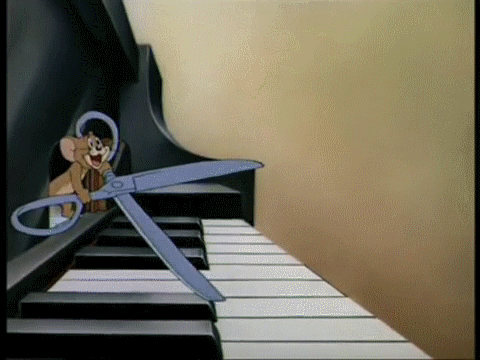
Luckily this wasn't something I had to deal with
The part with the runs perhaps intimidated me more than any other part of the piece. The left hand leaped between chords and bass notes that went quite low into the bass register, while the right hand ascended all the way to the top of the keyboard. I practiced the A and F# scales every day for weeks, with and without the left hand. I played them slow, I played them fast, I played them really slow, I played each note with portamento, then legato, and I divided the scale into a series of chords consisting of three or four consecutive notes at a time that I played in succession to get all my fingers to memorize the changing shapes. Eventually, the once-insurmountable section of this stupendous piece began taking shape. I only had the finale to tackle, which, as impressive as it sounds, was much easier than the majority of the piece. I have not written the optional cadenza to be played before the finale. My teacher suggested I find and learn the cadenzas written by Liszt himself. Perhaps as my understanding of music increases, I'll come up with something of my own.
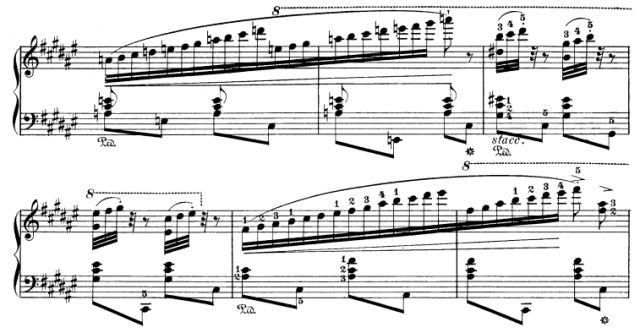
A Major and F# Major Scale Runs
My first public performance of the Second Hungarian Rhapsody went well. I made multiple mistakes, especially towards the end - however the performance was very well received by the audience. I have performed it a few times since, improving each time, and continue working with my teacher on fine-tuning my sound.
There are plenty of musical pieces out there that are beautiful. There are also plenty that are merely technical and difficult to play. And once more, there are pieces that are both beautiful and technical at the same time. But rare is the piece that takes itself so lightheartedly, while being the utmost expression of both genuine beauty and sheer skill. I am privileged to have had the time, resources, and help to have built the ability to experience such wonderful music from the first person. What I have achieved is but a small stepping stone - it may take years to fully grasp and express the depth, vigor, and humor of the Second Hungarian.
I would have loved to have been able to include the Cat Concerto episode as a conclusion to this article, however I could not find the full version. So here is a rare recording of Rachmaninoff, playing the Second Hungarian with impressively little sustain pedal usage:

This is one of the best posts that I've read in a long while and I read dozens every day. None of my music teachers in school or university has ever explained the routine and preparation of playing a piece on the piano in the way that you have. That it is tied to one of my all-time favorite cartoons, Tom and Jerry, is purely a bonus. Thanks so much for sharing. I found you through the #payitforward contest. You were featured by @bengy and rightly so. Congratulations. I wish you continued success.
Cheers @energyaddict22, thanks for stopping by!
Hi @giobardzero,
Thank you for this post. I appreciated your write-up. You gave a nice sense of the level of musical maturity that is needed to play Liszt's "Hungarian Rhapsody No. 2." And your Tom and Jerry references brought back many childhood memories. I also enjoyed listening to the youtube recording by Rachmaninoff.
We have shared this on the Steemit's Best Classical Music (SBCM) Facebook page and included it in our post, Steemit's Best Classical Music Roundup [Issue #29]. You and the other featured authors will each receive a share of that post's rewards when it closes.
Welcome back with a well deserved curie! I had featured your post on this post: https://steemit.com/payitforward/@bengy/pay-it-forward-curation-contest-week-3-entry as part of a curation competition by @thedarkhorse. However, it looks like someone much bigger beat me to it!
Thank you @bengy!
No problem, you should also consider entering it in this contest
https://steemit.com/educatorshowdown/@novili/educator-showdown-round-5-or-a-music-tutorial-contest-from-the-steem-music-alliance-dsound-community-initiative
Man there's just so much going on in this community, it's hard to wrap my head around it! Thank you @bengy for all your help so far, will enter it shortly.
Good, just change one of the tags and submit the link.
Superb post, thanks for sharing! It has been resteemed and will appear in the next curation (with a SBD share for you!)
Your post has been supported and upvoted from the Classical Music community on Steemit as it appears to be of interest to our community. You can find details about us below.
The classical music community at #classical-music and Discord.
Follow our community accounts @classical-music and @classical-radio.
Follow our curation trail (classical-radio) at SteemAuto
Woot thank you very much! Cheers!
Great post. I love how you shared so much about the piece and tied it in with events from your own life. It was written so well! I loved the inclusion of the Tom and Jerry photos as well. I immediately knew what piece you were talking about as soon as I saw them. Thanks for sharing.
Absolutely - thank you! I love all those cartoons for that reason - they introduced kids to classical music and are so recognizable! I wish I couod have found that episode online, would have been the perfect conclusion (and I just want to watch it again haha)
Great post! I was (still am) a big Tom & Jerry fan. I have a hunch that like us so many kids first heard classical music in The Cat Concerto, or perhaps some similar Looney Toons cartoon. It was such a great time to be a kid, and a fun way to be introduced to classical music. I am happy to see it inspired you enough to get into music.
This post was nominated by a @curie curator to be featured in an upcoming Author Showcase that will be posted early Monday (U.S. time) on the @curie blog. If you agree to be featured in this way, please reply and:
You can check out our previous Author Showcase to get an idea of what we are doing with these posts.
Thanks for your time and for creating great content.
Gene (@curie curator)
Hi Gene (@randomwanderings)
Thank you for taking the time to read through my post. Would love to be featured! You're welcome to quote the post.
As far as the info statements: this post details the process of learning one of my all time favorite pieces of music. I'm a multi-instrumentalist and a songwriter who also plays guitar and sings folk tunes. I run two open mics in Denver, where I reside, and also teach music.
Cheers!
Gio
I liked your post, it was pretty long, but there was no way you could break it up into smaller chunks. I loved reading about your journey with this one piece of music. I loved that Tom and Jerry episode. Like the music it was fun. I wonder if one day we will see a Dueling Piano's thing with this music piece, like dueling banjos type of thing.
There's definitely 4 hands versions of this piece, either on 2 pianos or 1!
Someone needs to make a video of it, with the two piano players chucking it up like like Tom and Jerry
Great writing about a superlative piece of music. I too have devoted much time/energy to learn this at the bequest of my son. 👏 would love to hear your interpretation!
Regards from Japan
eLi gARF, PiaNOwarist
Thanks! I'm playing it at a recital next month, perhaps I'll make a recording!
Sure hope you do!
I just did a video on FB
Not sure if the link will work here but hope you might enjoy some of my rendition using comic book effect on Clips
https://www.facebook.com/eLigARFone/videos/10155198108801290/
Sorry that fb link doesn’t work here so I put it up on YouTube
Liszt Hungarian Rhapsody number 2
eLi gARF、
piaNOwarist
📞 090♪8467♪8042
Hey @giobardzero ,
The new @curie Author Showcase is now up and ready for viewing.
https://steemit.com/curation/@curie/curie-author-showcase-april-23rd-2018
Cool, thank you for the feature!
This post with its Tom and Jerry inclusion was as lighthearted and technical as the piece itself (which I listened to sitting on the toilet, sorry Mr Lizst, and which I instantly recognised in its second half, which was pleasurable brushing my teeth to).
Glad to have found your writings :)
Thank you!